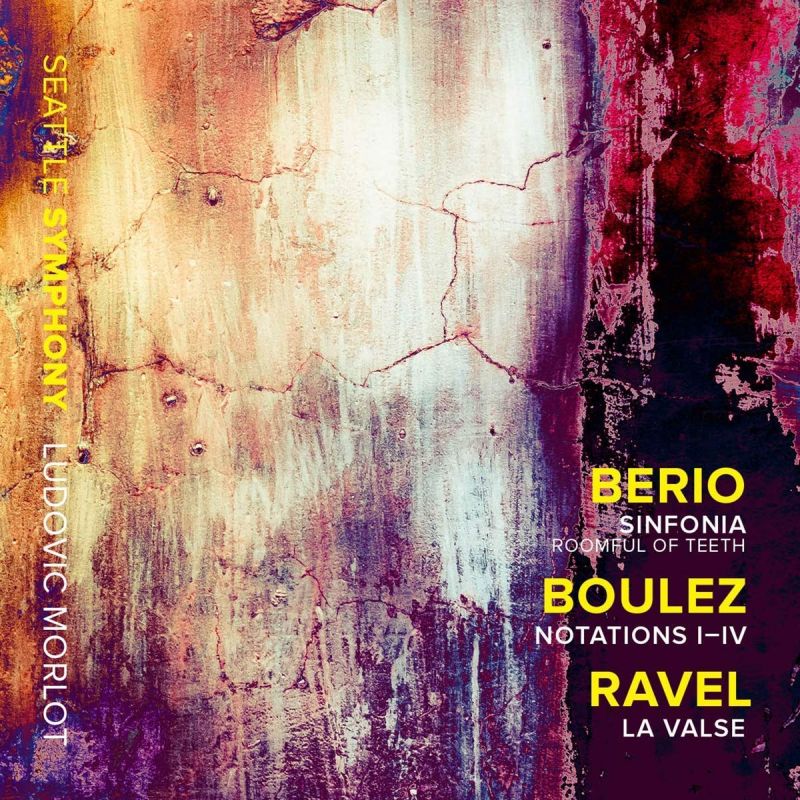BERIO Sinfonia BOULEZ Notations I-IV RAVEL La valse (Morlot)
View record and artist detailsRecord and Artist Details
Composer or Director: Pierre Boulez, Luciano Berio, Maurice Ravel
Genre:
Orchestral
Label: Seattle Symphony Media
Magazine Review Date: 12/2018
Media Format: CD or Download
Media Runtime: 58
Mastering:
DDD
Catalogue Number: SSM1018

Tracks:
| Composition | Artist Credit |
|---|---|
| Sinfonia |
Luciano Berio, Composer
Luciano Berio, Composer Ludovic Morlot, Conductor Roomful of Teeth Seattle Symphony Orchestra |
| Notations |
Pierre Boulez, Composer
Ludovic Morlot, Conductor Pierre Boulez, Composer Seattle Symphony Orchestra |
| (La) Valse |
Maurice Ravel, Composer
Ludovic Morlot, Conductor Maurice Ravel, Composer Seattle Symphony Orchestra |
Author: Andrew Farach-Colton
There’s not much lightness or humour in Ludovic Morlot’s performance of the third movement, either, but it is wondrously psychedelic, the orchestral colours oversaturated and almost glaringly bright. He’s aided in this by the closely miked recording, which puts the teeming score right in your face. Note the groovy electric harpsichord popping out of the texture, and, in general, how this enhanced level of detail reveals Sinfonia’s craftsmanship. You can really hear how ingeniously Berio weaves the Sacre quotation into the fabric, for example (starting at 3'05"). I also like the ardent, youthful idealism tenor Eric Dudley brings to his spoken part, as it’s so evocative of the late ’60s. Throughout Sinfonia, in fact, the vocal ensemble Roomful of Teeth are superb: pure-toned, rhythmically vital and right at home in the music’s inherent theatricality.
To be clear, the lucidity in this performance is not simply due to the miking; Morlot is, as always, a punctilious conductor. Listen, say, to the jittery precision with which the brass and piano volley starting at 1'05" in the fifth movement. And, in fact, in Morlot’s hands, the entire finale becomes a study in texture, the cumulative effect subtly shifting the work’s centre of gravity away from the third movement to provide a riveting and immensely satisfying conclusion.
Boulez’s Notations are similarly articulate, and presented here in sound that’s far more naturally balanced. The third of the set is as atmospherically and creepily nocturnal as it should be, for instance, yet so finely grained it’s as if we’re hearing with the aural equivalent of night vision goggles. I wish the second (played last here) had more of the stridency Boulez asks for – Abbado with the Vienna Philharmonic (DG, 4/90) gets it exactly (and thrillingly) right – but it’s extremely well played nonetheless.
I have no cavils at all with Morlot’s dark vision of La valse, however. That there’s very little Viennese schmaltz is refreshing, his rubato is generally reined-in yet flexible, and he holds the brass in check until 10'45", when he finally lets loose to powerful effect – an explosive end to an action-packed and rewarding programme.
Discover the world's largest classical music catalogue with Presto Music.

Gramophone Digital Club
- Digital Edition
- Digital Archive
- Reviews Database
- Full website access
From £8.75 / month
Subscribe
Gramophone Full Club
- Print Edition
- Digital Edition
- Digital Archive
- Reviews Database
- Full website access
From £11.00 / month
Subscribe
If you are a library, university or other organisation that would be interested in an institutional subscription to Gramophone please click here for further information.




